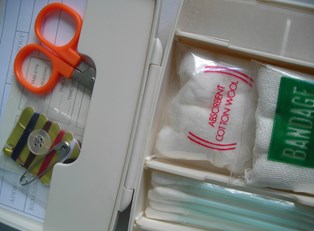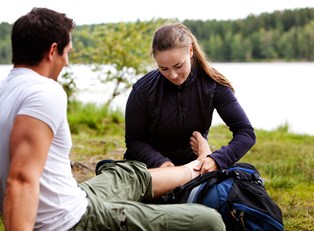Playing sports offers many fitness benefits, but injuries are also common and you should keep a sports first aid kit on hand just in case. Here are some of the most common injuries that can be addressed on-the-spot and the items your sports first aid kit should contain for that purpose.
Common Sports Injuries
Sprains, strains, fractures, bruises, cuts, scrapes, and sunburn are among the most common injuries associated with many types of sports. Sprains occur when ligaments are stretched or torn. Strains are pulled tendons or muscles. Bone fractures are a little less common than sprains or strains, but can occur due to falls, impact with another player or impact with equipment. Bruises, cuts, scrapes and sunburn tend not to be as serious as sprains, strains or fractures, but you should treat these promptly to prevent further complications.
First Aid Kit Contents
Your sports first aid kit should contain chemical cold packs, elastic bandages, athletic tape, pain tablets, pain relieving creams or gels, splints, and medical scissors. These items are used for treating sprains, strains and minor fractures. Chemical cold packs are a safe, convenient alternative to using ice on injuries for reducing swelling. An elastic bandage or athletic tape can be used to keep an ankle, knee, wrist, or hand immobilized in cases of sprains, strains and some small fractures until the player receives professional medical attention. Pain tablets and creams can provide some relief for pain associated with these injuries.
Other things you should include in your kit include hypoallergenic medical gloves, sterile wound wash, antiseptic spray, antiseptic towlettes, antibiotic ointment, gauze pads, gauze bandages, medical tape, adhesive bandages, bandage scissors and tweezers. Prompt treatment of cuts and scrapes helps prevent infection and safeguards other players from blood-borne germs. Make sure to include different sizes and types of bandages so that you will be prepared to treat a variety of wounds. Butterfly bandages, for example, can be used to close gaping cuts while large gauze pads may be needed for large cuts or abrasions that are bleeding heavily. Tweezers of various sizes are helpful for removing foreign debris, such as splinters or piece of gravel, embedded in the wound.
Sterile eyewash and eye pads should be included in all sports kits. While some eye injuries are caused by accidental impact and require immediate professional attention, dirt and other debris in eyes is common in many contact sports. Sterile eyewash is used to flush foreign particles from the eyes to prevent eye injury. Eye pads are sometimes used to protect an injured eye until professional medical staff can treat the player.
Sunburn relief spray or creams take the sting from sunburn, and those containing aloe also speed healing. Sunburn aids should be included in all kits for outdoor sports.
Depending on the weather, type of sport played, age of the players and local rules and regulations, your sports first aid kit may need additional items such as an emergency blanket for treating hypothermia or an epinephrine pen to be used for severe allergic responses. Remember that it is always better to be overly prepared than under-prepared, and include any additional items you feel might come in handy for treating sports injuries.



